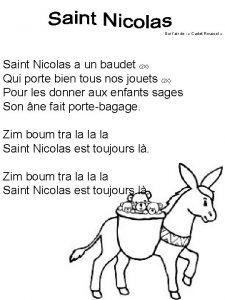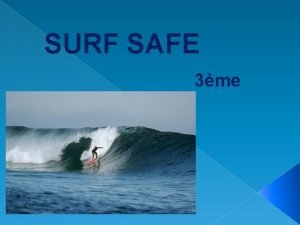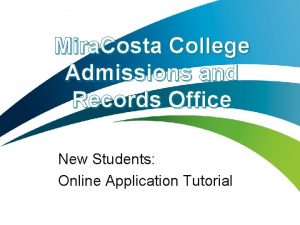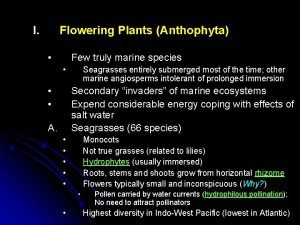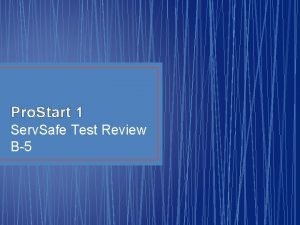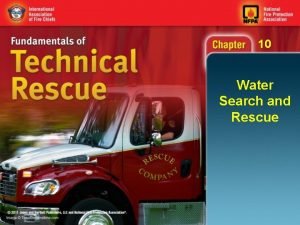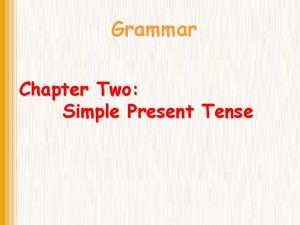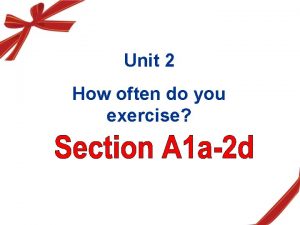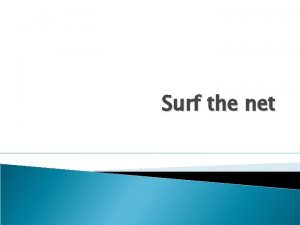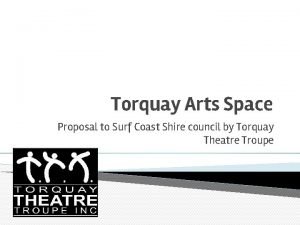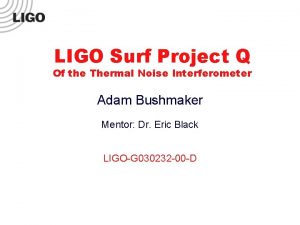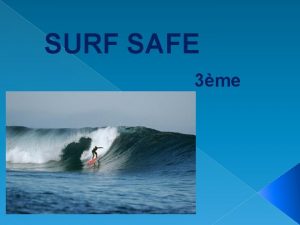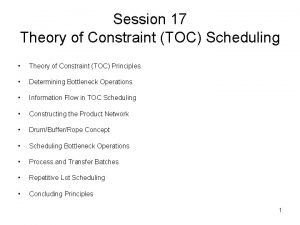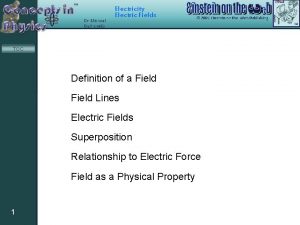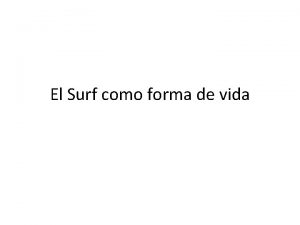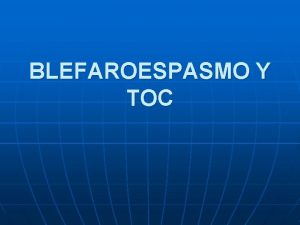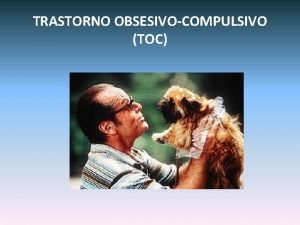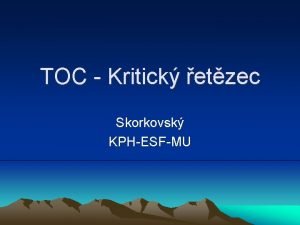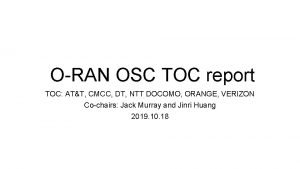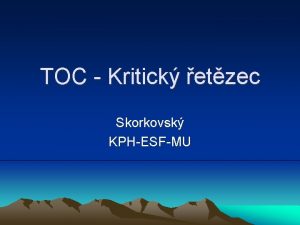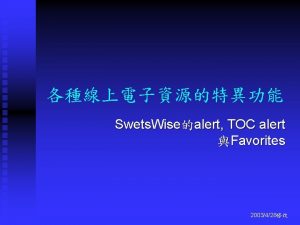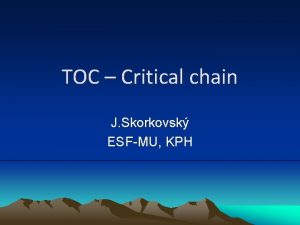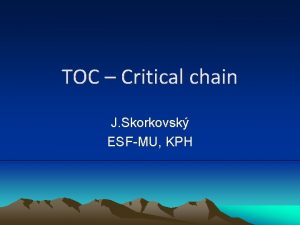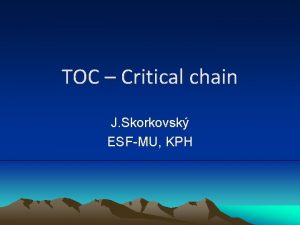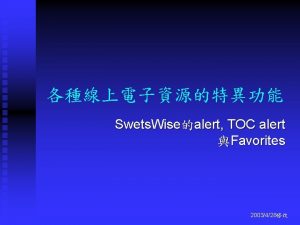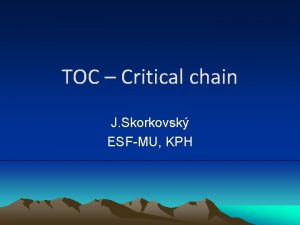Electricity Field LinesPot Surf TOC Definition of a



























- Slides: 27

Electricity Field Lines/Pot Surf TOC Definition of a Field Lines Electric Field Lines Definition of a Potential Surface Motion of Particles in an Electric Field Quiz 1

Electricity Field Lines/Pot Surf What is a Field? TOC Fields are properties that change their value depending on what point in space or time you are measuring them. They may depend on direction (vector fields) or they may not (scalar fields). Examples of Fields: Temperature Profile (scalar) Wind Velocity Profile (vector) 2

Electricity Field Lines/Pot Surf TOC Example of a Scalar Field Temperature is a function of position. This position is given by the latitude and longitude of the point where the temperature is taken. Graphical Representation N Mathematical Representation Position 3 Magnitude Latitude 28° 40° 41° 32° 30° 29° 47° 38° N Longitude 118° 100° 106° 123° 81° 86° 83° 73° 95° 91° W Direction Units 51 48 75 62 58 82 74 65 87 none degrees F

Electricity Field Lines/Pot Surf TOC Example of a Vector Field Wind Velocity is a function of position. This position is given by the latitude and longitude of the vector’s tail. Graphical Representation N Mathematical Representation Position 4 Magnitude Latitude 28° 40° 41° 32° 30° 29° 47° 38° N Longitude 118° 100° 106° 123° 81° 86° 83° 73° 95° 91° W 20 11 12 10 14 5 4 6 Direction* 315° 225° 85° 43° 44° 0° 2° Units mph * Angles for direction are taken counterclockwise from East.

Electricity Field Lines/Pot Surf TOC Wind velocity can be represented by placing arrows at many locations. Each arrow represents the value of the velocity at the location of the tail of the arrow. The direction of the arrow gives the direction of the wind velocity. The length of the arrow gives the magnitude of the wind velocity. 5

Electricity Field Lines/Pot Surf The wind velocity can also be represented by lines. TOC The lines do NOT connect the arrows! The lines are closer together where the magnitude of the wind velocity is greater. The direction of the wind velocity at a point on any line is tangent to the line. 6

Electricity Field Lines/Pot Surf Look at the example below… TOC 7 The first (on the left) set of field lines represents a uniform field that is twice the magnitude of the second (on the right). Both fields represent vectors that point to the right.

Electricity Field Lines/Pot Surf TOC Rules for Field Lines All electric field lines 1. Point in the direction of the electric field vector at every point. 2. Start at positive charges or at infinity. 3. End at negative charges or at infinity. 4. Have a number entering or leaving a charge which is proportional to the charge. 8

Electricity Field Lines/Pot Surf Here is another example… TOC 9 The first (on the left) set of field lines represents a radial field that is twice the magnitude of the second (on the right). The first is generated by a charge that is twice that of the second.

Electricity Field Lines/Pot Surf TOC Here is an example of how to find the direction of the electric field at a point on the filed line… Each point is tangent to the field line and points is the direction indicated by the black arrow. 10

Electricity Field Lines/Pot Surf TOC Positive point charges have electric field lines that point outward. Negative charges have electric field lines that point inward. The number of field lines is proportional to the amount of charge. 11

Electricity Field Lines/Pot Surf Definition of a Potential Surface TOC A surface is an equipotential surface if the electric potential at every point on the surface is the same. As charges move on an equipotential surface the electric force does no work. The electric field at a point is always perpendicular to the equipotential surface on which the point lies. The electric field always points in the direction of decreasing potential. 12

Electricity Field Lines/Pot Surf TOC Rules for Potential Surfaces All electric potential surfaces 1. Are perpendicular to the electric field. 2. Decrease in value as you move in the direction of the electric field. 3. Are often evenly spaced in terms of potential so that the distance between them is proportional to the magnitude of the electric field. 13

Electricity Field Lines/Pot Surf TOC Rules for Motion When subject to an electric force positive charges 1. Move in the direction of the electric field. 2. Move from higher to lower potential. negative charges 1. Move opposite the direction of the electric field. 2. Move from lower to higher potential. 14

Electricity Field Lines/Pot Surf TOC The electric field lines follow these five simple rules. . . 1. The number of field lines entering or leaving a charge is proportional to the absolute value of that charge. 2. The field lines leave positive charges and enter negative charges. 3. The field lines never cross each other. 4. Field lines are closer to each other where the field has a larger magnitude and farther from each other when the field has a smaller magnitude. 5. Charges follow the field lines (positive charges in the same direction as the field lines, negative charges opposite to them) 15

Electricity Field Lines/Pot Surf TOC 16

Electricity Field Lines/Pot Surf TOC If I have two charges as shown and the value of charge A is 2 μC, what is the value of charge B? A Answer: -3 μC 17 B

Electricity Field Lines/Pot Surf TOC Which is not a correct way to draw field lines? A. B. C. D. Answer: D 18

Electricity Field Lines/Pot Surf TOC Where is the field the strongest? C. A. D. B. Answer: C 19

Electricity Field Lines/Pot Surf TOC Which way will the electron initially accelerate? A. B. C. D. Up Down Left Right Answer: A 20

Electricity Field Lines/Pot Surf TOC Gauss’s Law follows these three simple rules. . . 1. By definition, flux is given by the equation Φ = EA cos(φ). 2. It also follows Gauss’s equation Φ = 4π k Qinside. 3. The electric field inside the material of a conductor is zero. 21

Electricity Field Lines/Pot Surf TOC What is the flux through the surface shown assume that the particles are electrons and protons? Answer: -1 x 4πke 22

Electricity Field Lines/Pot Surf TOC What is the flux through the surface shown assume that the particles are electrons and protons? Answer: 3. 62 x 10 -8 Nm 2/C 23

Electricity Field Lines/Pot Surf TOC A charge of -2 e is added to the spherical shell. Where does that charge go? A. B. C. D. It evenly distributes in the shell. It goes to the inside surface of the shell. It goes to the outside surface of the shell. Some will be on the outside surface and some on the inside surface of the shell. Answer: C 24

Electricity Field Lines/Pot Surf TOC A charge of -2 e is added to the spherical shell. A charge of 16 e is placed inside the shell. Where does the charge in the shell go? A. B. C. D. It evenly distributes in the shell. It goes to the inside surface of the shell. It goes to the outside surface of the shell. Some will be on the outside surface and some on the inside surface of the shell. Answer: D 25

Electricity Field Lines/Pot Surf TOC A charge of -2 e is added to the spherical shell. A charge of 16 e is placed inside the shell. How much charge is on the inside surface of the shell? Answer: -16 e 26

Electricity Field Lines/Pot Surf TOC A charge of -2 e is added to the spherical shell. A charge of 16 e is placed inside the shell. How much charge is on the outside surface of the shell? Answer: 14 e 27
 Au claire de la lune grand saint nicolas
Au claire de la lune grand saint nicolas Veux-tu briser du péché le pouvoir lyrics
Veux-tu briser du péché le pouvoir lyrics Static electricity and current electricity
Static electricity and current electricity Current electricity
Current electricity How are static electricity and current electricity alike
How are static electricity and current electricity alike Surf au preterit
Surf au preterit Miracosta admissions office
Miracosta admissions office Alexa
Alexa Surf grass phylum
Surf grass phylum Surf safe test
Surf safe test Surf's up flyer microsoft word
Surf's up flyer microsoft word Objectives of search and rescue team
Objectives of search and rescue team Present perfect surf
Present perfect surf Jogo de subway surf
Jogo de subway surf Structure of simple present tense
Structure of simple present tense How often do you surf the internet
How often do you surf the internet Let's talk about internet
Let's talk about internet Handysurf
Handysurf Mind-surf.net puertas
Mind-surf.net puertas Torquay theatre troupe
Torquay theatre troupe App surf
App surf Ligo surf
Ligo surf Surf au preterit
Surf au preterit Voltexmap
Voltexmap Toc in education
Toc in education Toc in pharmaceutical industry
Toc in pharmaceutical industry Toc mérés
Toc mérés Toc scheduling
Toc scheduling
